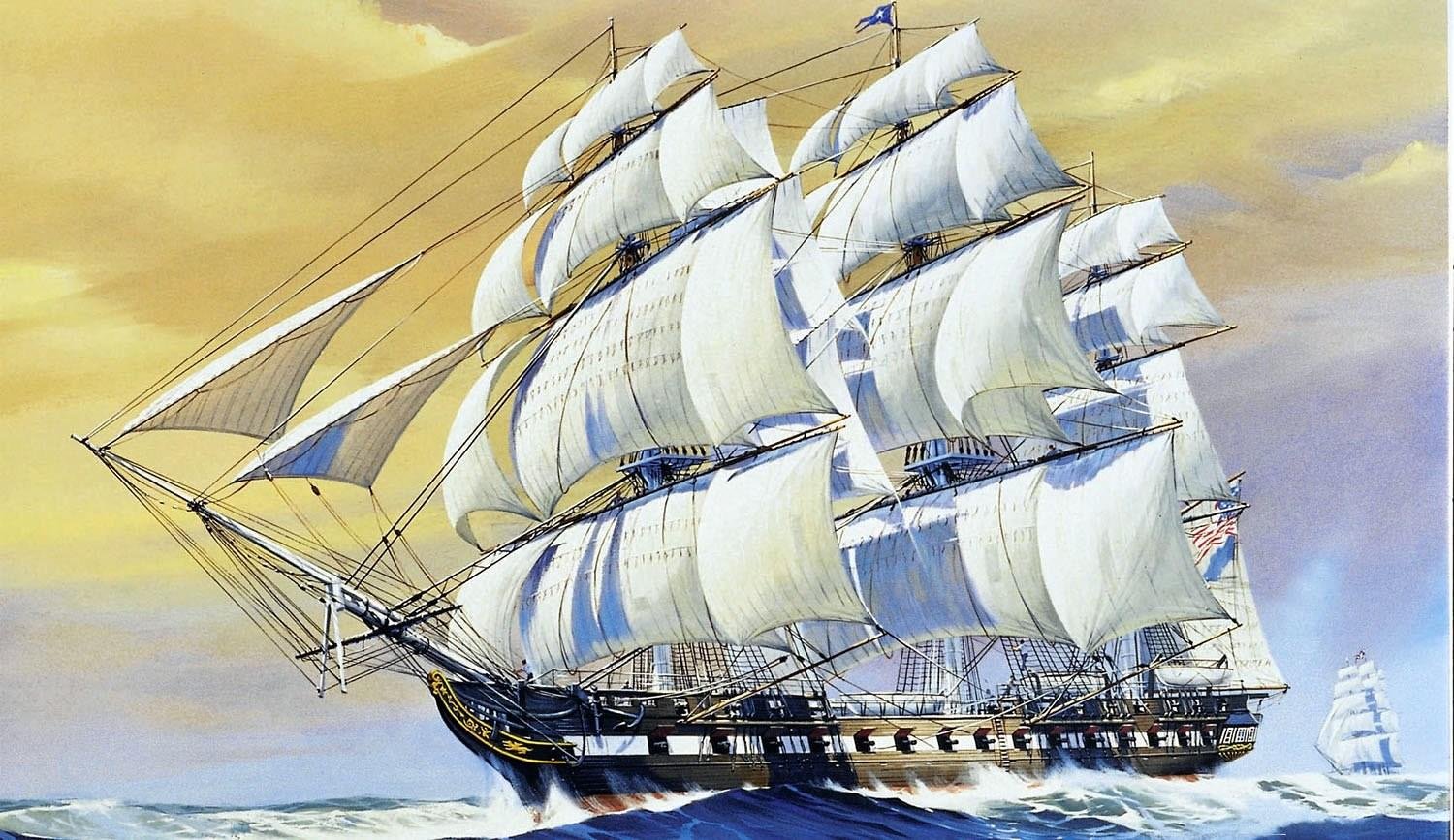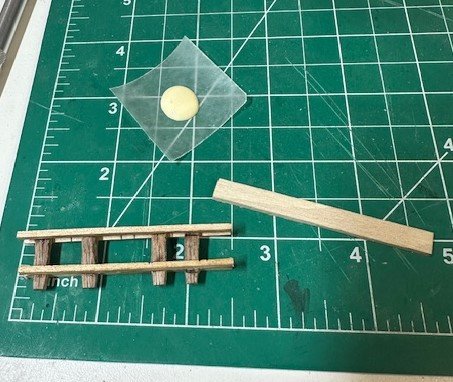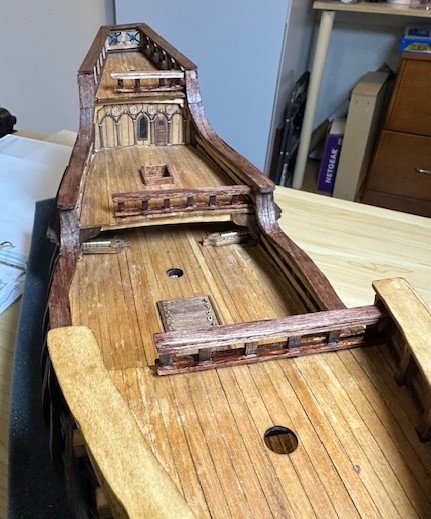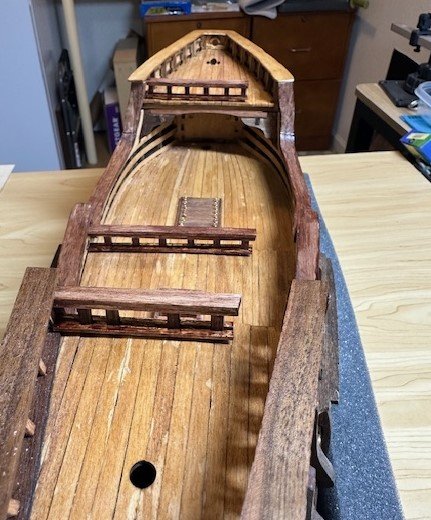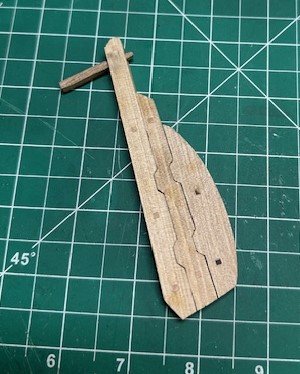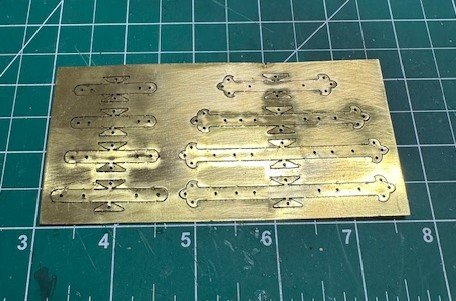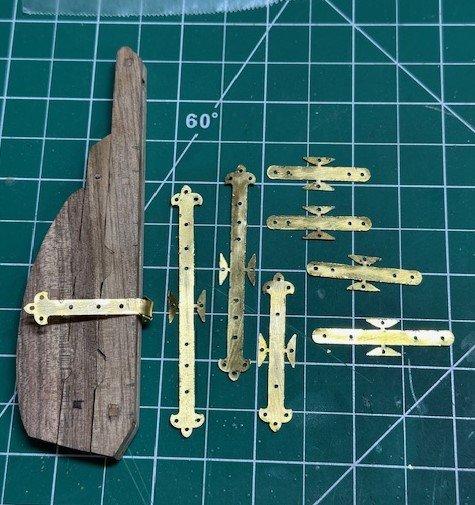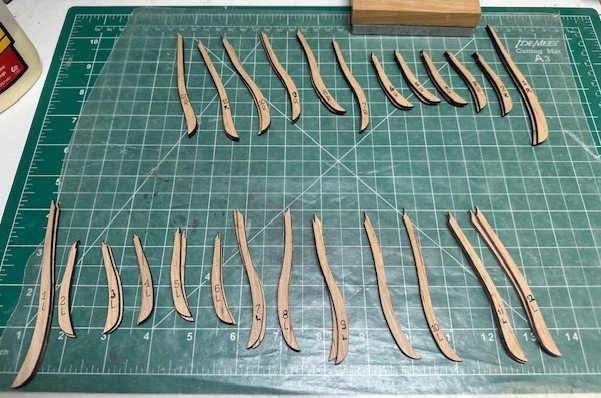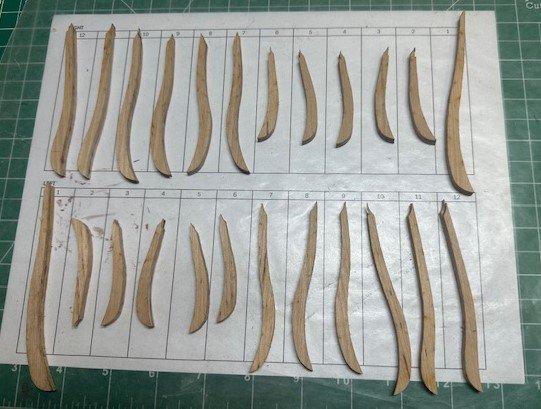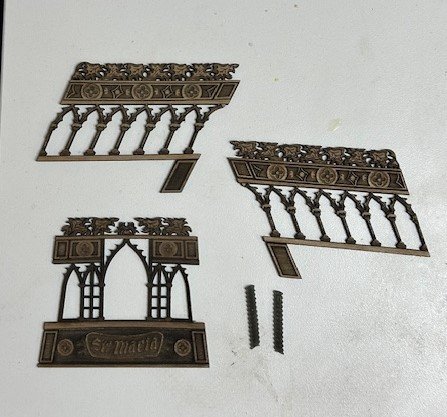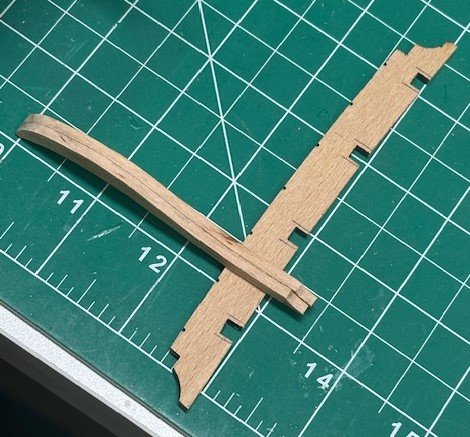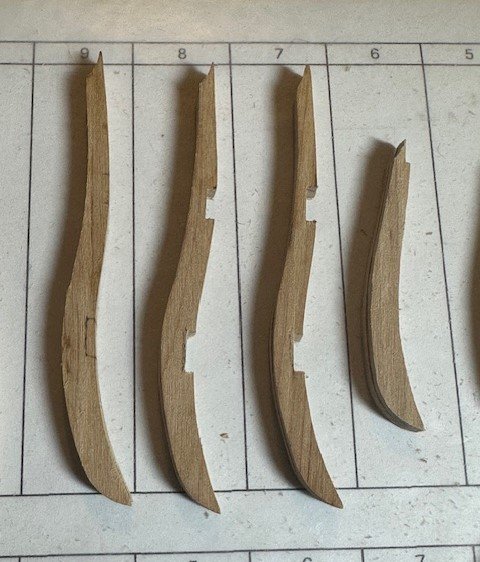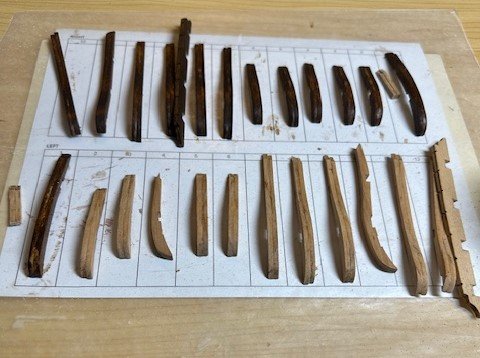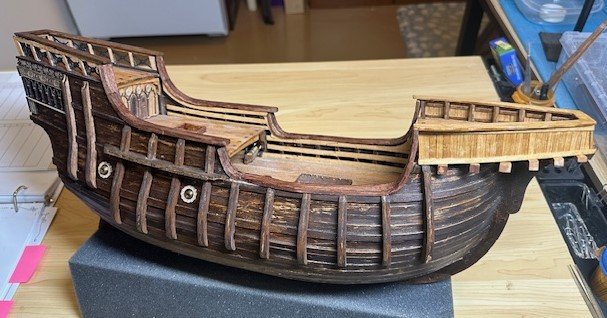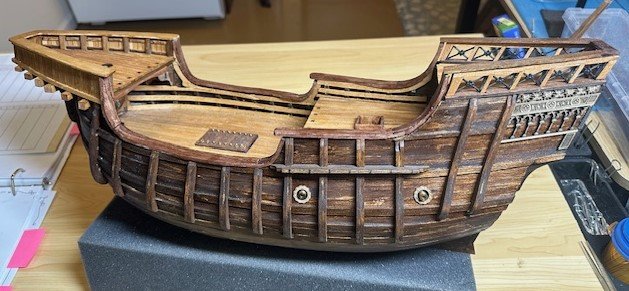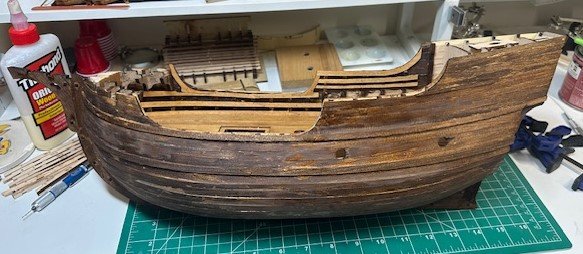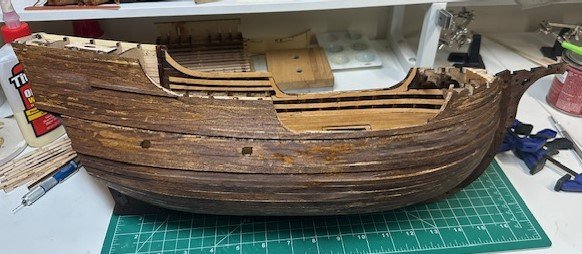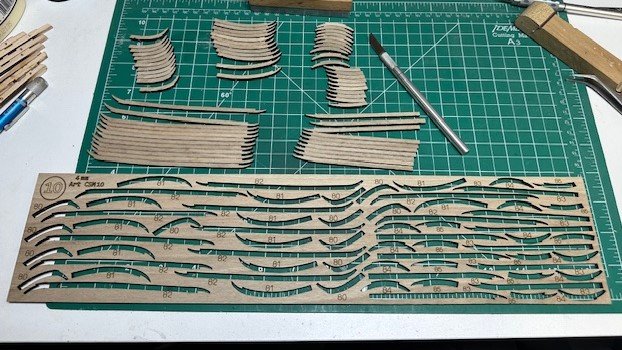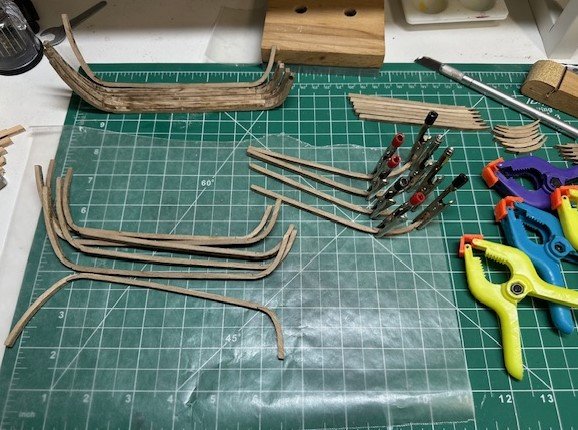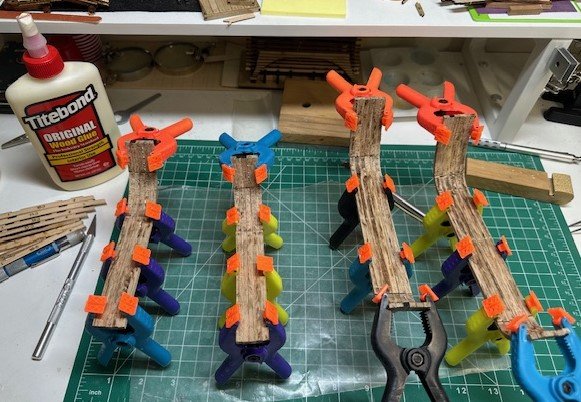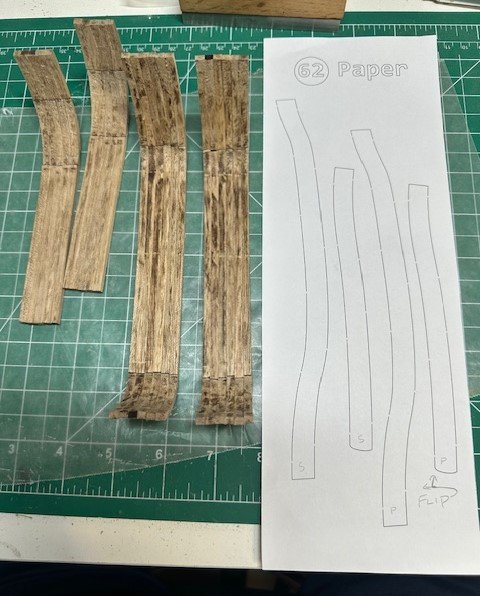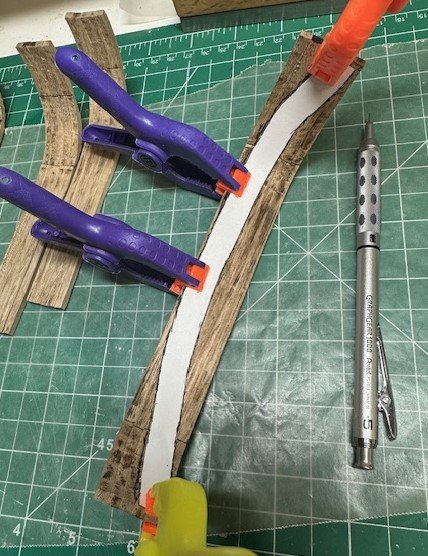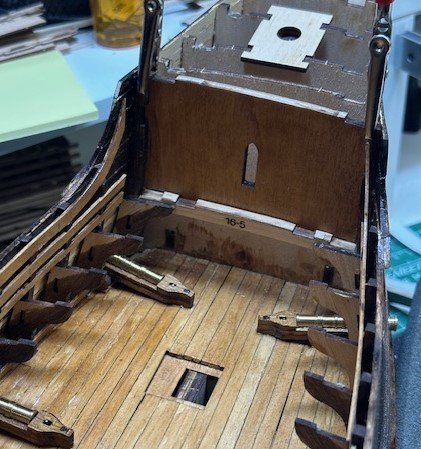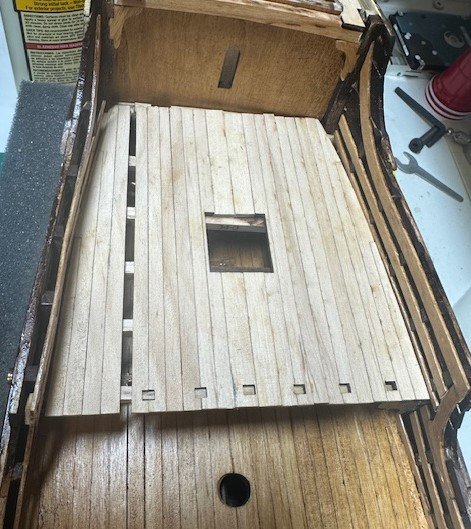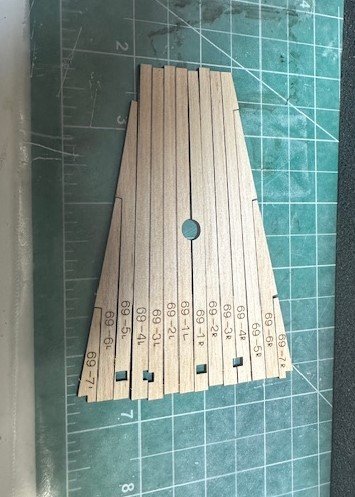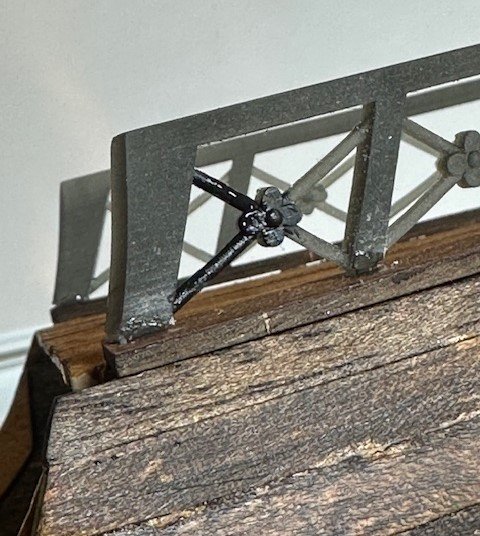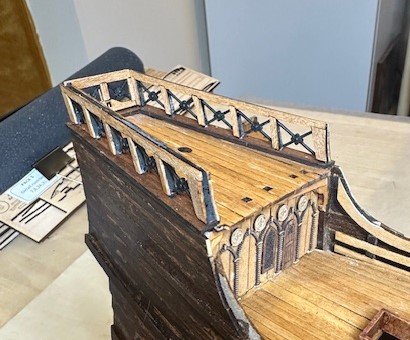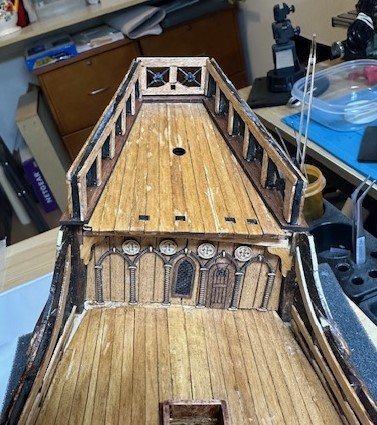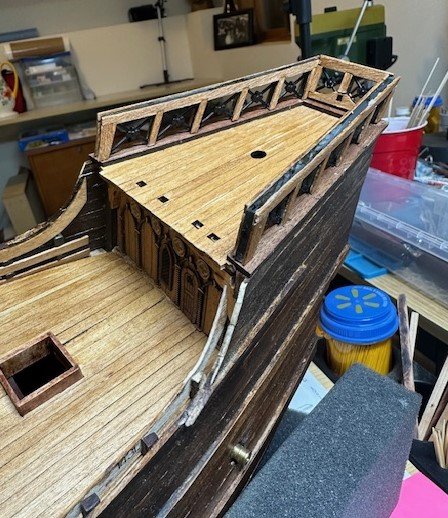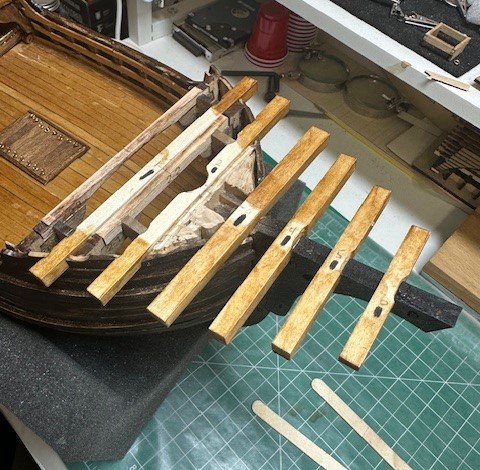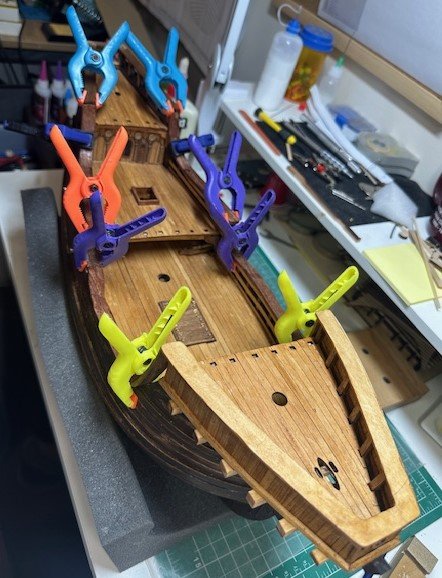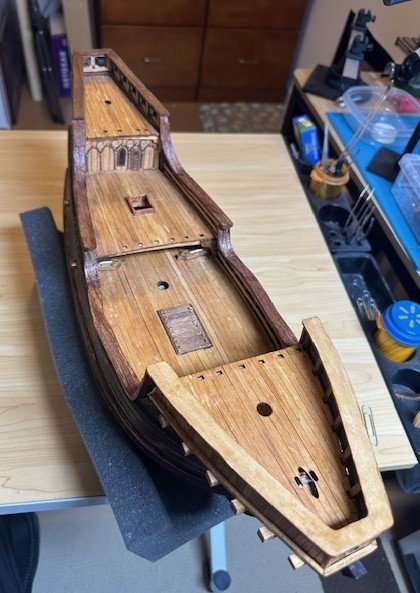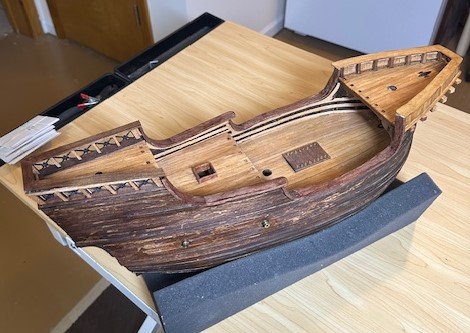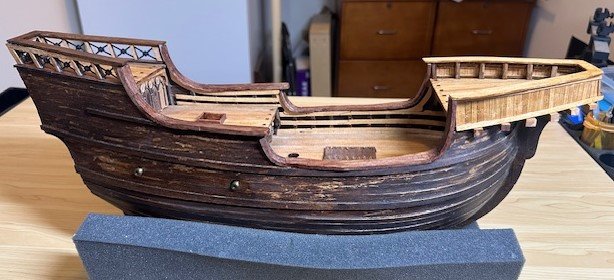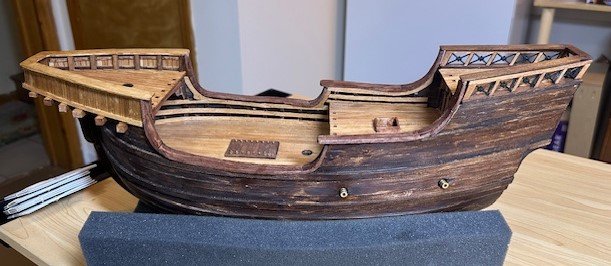-
Posts
1,043 -
Joined
-
Last visited
Content Type
Profiles
Forums
Gallery
Events
Everything posted by GGibson
-
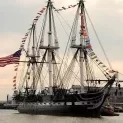
USS Constitution by mtbediz - 1:76
GGibson replied to mtbediz's topic in - Build logs for subjects built 1751 - 1800
Spar deck is really coming together. Starting to get a better feel of how it will look. Excited for you! -
OK, another quick little update on what I've just finished... Three of the decks (forecastle deck, quarterdeck & poop deck) have railings. The railing pieces in the kit were in multiple sheets, so I popped them out, cleaned them up, and assembled each of them, noting the positioning of the posts so they fit into the predetermined deck slots. Gave them each a coat of prestain and then the Minwax Satin Bombay Mahogany stain. After they were each secured on the respective decks, it looks like I may need to give them another coat of stain before we call it good. However, it's nice to see these decks continuing to take shape. Working on the rudder now. I'll show how far I've gotten today. Again, like all of the wood pieces, I popped the rudder parts out of the sheets and cleaned up the laser char. The rudder, like the hull, is double-thickness so parts were glued together and then fit to create the full rudder piece. The kit provides a sheet containing the brass pintles and gudgeons. These were popped out, cleaned up, and I began shaping them using my parallel pliers, which worked out well. Will work now on where to position the four (4) pintles to the rudder and where to position the corresponding gudgeons to the transom. A 1mm brass rod will serve as the pin for each and will be secured on the pintle so that the rudder slides onto the transom. I will also be staining the rudder and hinges so that it matches as best it can, of course, with the hull color. Baby steps, but steps closer to completion, so that's a good thing. Appreciate the likes, comments and critiques.
- 58 replies
-
- Santa Maria
- Ships of Pavel Nikitin
-
(and 1 more)
Tagged with:
-
Thank you, Mustafa. Appreciate the kind words. And, yes, I have looked at your Santa Maria Mantua build. Actually, I think I have looked at both, but have referred back to your Mantua build more frequently at various points. 👍🏆
- 58 replies
-
- Santa Maria
- Ships of Pavel Nikitin
-
(and 1 more)
Tagged with:
-
Great work on the Red Jacket, John! Enjoy the warmer weather! Our oldest granddaughter grew up in South Florida but decided to go to college in Kansas close to us, so she is definitely getting a quick introduction to cold winters, scrapping ice and snow from car windshields, etc! I try not to tease her too much...
- 165 replies
-
- Red Jacket
- Marine Model Company
-
(and 2 more)
Tagged with:
-
Hey Peter! My 2 cents... if the bottom picture is from the Hunt practicum, they look way bigger than they need to be. If I can try to pretend to be Jon Gerson with any type of accuracy on my part, attached are the plans for the carronades that I had downloaded a while back as a part of my prep for my own eventual build and the concerns y'all have expressed regarding the various carronade configurations. I'll let you do the scale math for the 1:76.8 rate but, if I am reading the plans correctly, the eyebolts are 1-1/4" in diameter in real size. What does that convert down to in our scale in inches or millimeters? Also, the plans' list of materials states there are twelve (12) of these eyebolts for two cannons, which is six each (if I'm doing that math correctly... 🤔). I can spot four (4) of them on the Detail "13-A" drawing (Item #13 in the parts list), but not finding the other two. Anyways, I think you are good with the eyebolts you have, if they even need to be a bit smaller. The carronades, though, that you have made look great! EDIT: Just realized (duh) that these plans are for the 'elevator screw' type carronades and not the ones you have made. Not sure how that changes the measurements on the eyebolts. Sorry!! 6184310-Carronade.pdf
-
Another short update... Trying to complete everything on the outside of the ship, so the ship's buttock fenders (is that the proper term for these?) were next on the to-do list. Like almost everything else in this Santa Maria kit, these fenders were provided in the laser-cut sheets. The plan was to pop these out and match two of them together to make the buttock lines thicker as they were placed on the outside of the hull. In order to not mix them as I was gluing them together and fitting them, I made a little box chart to assist me in the organization. There were also some design pieces included in the kit that needed to be placed on the hull and stern below the poop deck. Since these were critical for the placement of the aft fenders, the pieces were secured on the ship's exterior with some CA glue. The buttock fenders off of the quarter deck needed to be placed so that the kit-provided channel board would fit based on the spaced slots in the board. In hindsight, I really messed up in preparing each of the buttock rider lines for placement. They needed to fit smoothly over the wale strakes and, rather than cutting the wale strakes back to the hull where the buttock fenders crossed, I measured and milled slots into each of the buttock rider pieces. Nice way to use my Proxxon mill, but it was not the best way to fit these vertical boards. After they were milled but before final placement, I stained them, first with a pre-stain, and then with the same Minwax Honey stain that, of course, I used for the hull. They were then secured to the outer hull with CA glue and the channel board secured, as well. Still a bit more to do on the exterior, placing the nails in the buttock fenders, securing the rudder, and a few other things, but think I will work on the three decks' railings and ladders next. Anxious to get this one done. As always, appreciate the follows, the clicks and the comments.
- 58 replies
-
- Santa Maria
- Ships of Pavel Nikitin
-
(and 1 more)
Tagged with:
-

USS Constitution by mtbediz - 1:76
GGibson replied to mtbediz's topic in - Build logs for subjects built 1751 - 1800
Great work on the carronades, Mustafa! And it is exciting to see how the view of the gun deck is coming together, even as you add these carronades to the spar deck. Have been curious how that was all going to look. Very nice, sir! 🏆 -

USS Constitution by mtbediz - 1:76
GGibson replied to mtbediz's topic in - Build logs for subjects built 1751 - 1800
The carronades are looking really sharp in place, Mustafa! How are you securing the carriages to the deck? Simply by using PVA glue? The spar deck is really taking shape! 🏆👍 -

USS Constitution by mtbediz - 1:76
GGibson replied to mtbediz's topic in - Build logs for subjects built 1751 - 1800
The eyebolts look really good, Mustafa! And really look nice after they are blackened. When making them, did you bend them first and then create the loops, or first make the double loops and then bend the end? Which did you find was easier and more accurate for you? -
Nice lines, sir. Looking very sharp. 🏆 I bought one of those OptiVISOR magnifiers a few years back (maybe it was when I was working on my own lobster smack). Had to send it back... it didn't fit my 7 7/8 noggin. 🤷♂️🤣
- 59 replies
-
- muscongus bay lobster smack
- Model Shipways
- (and 2 more)
-
Thanks, Neil. Appreciate the follow and comments.
- 58 replies
-
- Santa Maria
- Ships of Pavel Nikitin
-
(and 1 more)
Tagged with:
-

Byrnes Table Saw on Ebay UK
GGibson replied to Some Idea's topic in Modeling tools and Workshop Equipment
Yep, it's true. Congrats, pppilot, on your new saw. I've had my new Byrnes saw since August. Ordered it on 8/5, received it on 8/13. Donna has been awesome in getting Byrnes Model Machines back to operational. Donna told me that Mike was a protege of Jim's and has helped her tremendously in that effort. -
Well, I've completed another phase in this Santa Maria build, so thought I'd post an update with the progress I have made and the pictures I have taken to-date. At my last update at the end of December, I had not yet stained the outer hull, so it was time to do that. I think I had noted that Pavel Nikitin had his own set of paints/stains that he was recommending but, being the poor sprayer that I still am, I decided to use more conventional stains and brush or wipe them on. For the hull, I wanted a darker stain, so I opted for Minwax Honey wood finish. I wiped it on the hull, then sanded and used some steel wool to smooth it out some, then applied a 2nd coat. May do a bit more touchup before completion, as it is a bit "splotchy" in spots, but it gives a decent impression, I think, of how a 15th century ship may have looked. Next task was to work on the main deck and quarter deck rails. The kit's quarter deck rails consist of 5 sets of two rail pieces glued together to make the proper rail width. while the kit's main deck rails consist of 6 sets of three rail pieces joined to make its rail width. The char on all of these pieces was removed the best I could using my Dremel with a 220-grit sanding disc. Once these were all glued together to form two sets of rails, the kit provided a sheet which was needed in order to cut and shape each of the rails to their proper form. That was completed and then they were set aside for now, waiting to be stained and then placed once the decks were completed. There is a back wall for the quarter deck that really isn't discussed anywhere in the pictorial instructions but suddenly shows up in a subsequent picture, so we added that now while also working on the quarter deck planking. As the provided planks were placed on the quarter deck braces, there was a gap in the planking, so I cut an extra piece using the sheet that the planks came from and filled that gap. The poop deck planking was also laid out. Again, as is done with all of Pavel's sheet pieces, you can see the numbering on the planks for identification and placement but, of course, these were flipped/rotated when secured on the ship, so the numbers are not visible. The rail system that was provided in the kit for the poop deck was a dark gray resin material. Most of it would be covered by wood slats, but the decorative "X" supports were painted black in order to stand out a bit better. The top rail isn't in these pictures, but you'll see it in later pictures. The poop deck came out looking fairly well. Now to the front of the ship. I had previously completed the forecastle deck but have not yet secured it to the ship itself. I had also worked previously on the braces that go under the forecastle deck, but they were a bit shorter than I wanted, so I re-did them so the braces extend out a bit more on the sides. I stained the braces using the same Minwax Satin Antique Walnut that I used for the decks. The black marks on each of the braces just helped me remember what side to face up during placement, as the forecastle deck will be placed on top and cover the markings, anyway. Once the forecastle deck was placed and secured, I could then place the main deck rails and quarter deck rails that I had previously completed. They seemed to go on fairly well, but I will need to look at filling a few gaps between the rails and the hull where needed. But, with the placement of the rails, that pretty much completes this phase of construction. I think the next project is to work on the vertical buttock riders that are placed on the hull along with the channels, and then there are several deck items to work on, including rails, ladders, the windlass, etc. So, for now, this is how my Santa Maria looks. Appreciate those of you who have been peeking in with the likes, comments and advice. Thanks...
- 58 replies
-
- Santa Maria
- Ships of Pavel Nikitin
-
(and 1 more)
Tagged with:
-
All great historical research and discussion, gentlemen! It is going to be interesting to watch how each of you complete your spar decks and what combinations of 1812-era carronades vs. the 1927-1931 restoration castings each of you place on your spar decks. Of course, I'm watching it all with great interest and admiration. Carry on, fellas! 👍🏆
-

USS Constitution by mtbediz - 1:76
GGibson replied to mtbediz's topic in - Build logs for subjects built 1751 - 1800
When this discussion of using plexiglass for the spar deck planking was raised as an idea, I thought it had some merit, but I, too, was curious whether one would cut it as one full sheet or as individual planks. And, as Mustafa questioned, as well, if cut as individual planks, how would they be secured and would any visible adhesive (once dried) have any effect on the appearance? How would that also affect any faux-caulking applications between planks and its appearance? Very cool idea, but not sure it's ever been done for deck planking before. Doing a search for plexiglass on MSW, and you get 19 pages of posts regarding display cases, but none of the posts deal with deck planking. But, visualizing how it would look, I have to admit I'm intrigued. -

USS Constitution by mtbediz - 1:76
GGibson replied to mtbediz's topic in - Build logs for subjects built 1751 - 1800
Very interesting, Mustafa! Yeah, didn't know how far in you were planning on planking from the carriages, leaving visual "windows" on either side of the centerline, or leaving the centerline open. I'm excited to see how you have envisioned this and see it come together! And I am not familiar with the hornbeam wood but in reading up on it, it sounds like a very hard wood that is used a lot in building percussion instruments, handles, wheels and flooring (even if that flooring is only 1.5mm thick!). They say it's a very white wood and it looks that way in your pictures. Are you staining the spar deck, just putting a topcoat on it or leaving it natural? Should look really nice when you are finished, sir!
About us
Modelshipworld - Advancing Ship Modeling through Research
SSL Secured
Your security is important for us so this Website is SSL-Secured
NRG Mailing Address
Nautical Research Guild
237 South Lincoln Street
Westmont IL, 60559-1917
Model Ship World ® and the MSW logo are Registered Trademarks, and belong to the Nautical Research Guild (United States Patent and Trademark Office: No. 6,929,264 & No. 6,929,274, registered Dec. 20, 2022)
Helpful Links
About the NRG
If you enjoy building ship models that are historically accurate as well as beautiful, then The Nautical Research Guild (NRG) is just right for you.
The Guild is a non-profit educational organization whose mission is to “Advance Ship Modeling Through Research”. We provide support to our members in their efforts to raise the quality of their model ships.
The Nautical Research Guild has published our world-renowned quarterly magazine, The Nautical Research Journal, since 1955. The pages of the Journal are full of articles by accomplished ship modelers who show you how they create those exquisite details on their models, and by maritime historians who show you the correct details to build. The Journal is available in both print and digital editions. Go to the NRG web site (www.thenrg.org) to download a complimentary digital copy of the Journal. The NRG also publishes plan sets, books and compilations of back issues of the Journal and the former Ships in Scale and Model Ship Builder magazines.

